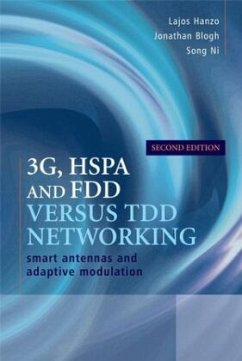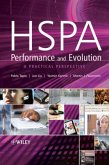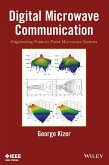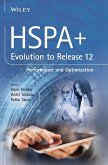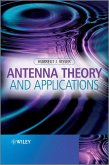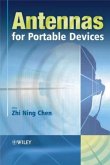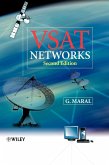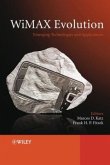Lajos Hanzo, Jonathan S. Blogh, Song Ni
3g, Hspa and Fdd Versus Tdd Networking
Smart Antennas and Adaptive Modulation
Lajos Hanzo, Jonathan S. Blogh, Song Ni
3g, Hspa and Fdd Versus Tdd Networking
Smart Antennas and Adaptive Modulation
- Gebundenes Buch
- Merkliste
- Auf die Merkliste
- Bewerten Bewerten
- Teilen
- Produkt teilen
- Produkterinnerung
- Produkterinnerung
3G, HSPA and FDD versus TDD Networking, Second Edition is the only book that contrasts the network capacity gains that may be achieved with the advent of adaptive antenna arrays and HSDPA-style adaptive modulation techniques in the context of FDD and TDD CDMA cellular networks. In the five years since the first edition of this book was published the wireless landscape has evolved further. The new book addresses the recent developments in the field of HSDPA-style wireless networking, focusing particularly on the issues and challenges of FDD versus TDD networking. These solutions are…mehr
Andere Kunden interessierten sich auch für
![Hspa Performance and Evolution Hspa Performance and Evolution]() Pablo TapiaHspa Performance and Evolution142,99 €
Pablo TapiaHspa Performance and Evolution142,99 €![Digital Microwave Communication Digital Microwave Communication]() George KizerDigital Microwave Communication178,99 €
George KizerDigital Microwave Communication178,99 €![HSPA+ Evolution to Release 12 HSPA+ Evolution to Release 12]() HSPA+ Evolution to Release 12114,99 €
HSPA+ Evolution to Release 12114,99 €![Antenna Theory and Applications Antenna Theory and Applications]() Hubregt J VisserAntenna Theory and Applications112,99 €
Hubregt J VisserAntenna Theory and Applications112,99 €![Antennas for Portable Devices Antennas for Portable Devices]() Zhi Ning Chen (ed.)Antennas for Portable Devices153,99 €
Zhi Ning Chen (ed.)Antennas for Portable Devices153,99 €![Vsat Networks Vsat Networks]() Gerard MaralVsat Networks186,99 €
Gerard MaralVsat Networks186,99 €![WiMAX Evolution WiMAX Evolution]() WiMAX Evolution164,99 €
WiMAX Evolution164,99 €-
-
-
3G, HSPA and FDD versus TDD Networking, Second Edition is the only book that contrasts the network capacity gains that may be achieved with the advent of adaptive antenna arrays and HSDPA-style adaptive modulation techniques in the context of FDD and TDD CDMA cellular networks. In the five years since the first edition of this book was published the wireless landscape has evolved further. The new book addresses the recent developments in the field of HSDPA-style wireless networking, focusing particularly on the issues and challenges of FDD versus TDD networking. These solutions are particularly powerful in shadow-faded scenarios, when the antenna array elements experience correlated, rather than independent fading. Furthermore, the flexible up-link/down-link time-slot allocation of TDD is beneficial for supporting the Wireless Internet, but results in erratic interference fluctuations, which is efficiently combated by the antenna arrays and adaptive modulation. Additionally, whilst the adaptive modulation aided system simply drops the instantaneous transmission rate during instances of high interference, conventional networks would drop the call.
Builds on successful previous edition to include recent developments in the field of HSDPA-style wireless networking
Provides an all-encompassing self-contained overview of the subject for a wide range of readers of all levels.
Treats the topics of both physical-layer and network-layer aspects of wireless systems using a cross-layer optimization approach.
One of the first books to contrast in detail both FDD and TDD networking.
The material is presented clearly and logically allowing the uninitiated reader to commence reading it at fundamental non-mathematical conceptual level at the beginning of the book, while advanced readers can turn directly to the required chapter describing solutions to a number of wireless FDD or TDD networking problems. This book will inspire researchers, practicing engineers, operators, marketing engineers and advanced postgraduates.
Hinweis: Dieser Artikel kann nur an eine deutsche Lieferadresse ausgeliefert werden.
Builds on successful previous edition to include recent developments in the field of HSDPA-style wireless networking
Provides an all-encompassing self-contained overview of the subject for a wide range of readers of all levels.
Treats the topics of both physical-layer and network-layer aspects of wireless systems using a cross-layer optimization approach.
One of the first books to contrast in detail both FDD and TDD networking.
The material is presented clearly and logically allowing the uninitiated reader to commence reading it at fundamental non-mathematical conceptual level at the beginning of the book, while advanced readers can turn directly to the required chapter describing solutions to a number of wireless FDD or TDD networking problems. This book will inspire researchers, practicing engineers, operators, marketing engineers and advanced postgraduates.
Hinweis: Dieser Artikel kann nur an eine deutsche Lieferadresse ausgeliefert werden.
Produktdetails
- Produktdetails
- Verlag: Wiley & Sons
- 2. Aufl.
- Seitenzahl: 600
- Erscheinungstermin: 31. März 2008
- Englisch
- Abmessung: 249mm x 175mm x 38mm
- Gewicht: 1160g
- ISBN-13: 9780470754207
- ISBN-10: 0470754206
- Artikelnr.: 23820917
- Herstellerkennzeichnung
- Libri GmbH
- Europaallee 1
- 36244 Bad Hersfeld
- gpsr@libri.de
- Verlag: Wiley & Sons
- 2. Aufl.
- Seitenzahl: 600
- Erscheinungstermin: 31. März 2008
- Englisch
- Abmessung: 249mm x 175mm x 38mm
- Gewicht: 1160g
- ISBN-13: 9780470754207
- ISBN-10: 0470754206
- Artikelnr.: 23820917
- Herstellerkennzeichnung
- Libri GmbH
- Europaallee 1
- 36244 Bad Hersfeld
- gpsr@libri.de
Dr Lajos Hanzo is Professor of Wireless multimedia communications in the School of Electronics and Computer Science at the University of Southapton. He has over 30 years experience in communications and has held various academic posts in Hungary, Germany and the UK. He has been a member of the academic staff at Southampton University since 1986 where he currently holds the Chair in Telecommunications. Professor Hanzo has published 12 titles with Wiley/IEEE and has published about 700 research papers. Dr Jonathan Blogh received a Ph.D. degree in mobile communications from the University of Southampton. His current areas of research include the networking aspects of FDD and TDD mode third-generation mobile cellular networks and he received the Lord Lloyd of Kilgerran Memorial Prize from the Institute of Electrical Engineering, U.K., in 1997 for interest and commitment to mobile radio and RF engineering. Dr Song Ni received his PhD from the School of Electronics and Computer Science, University of Southampton. Formerly of Multiple Access Communications Ltd in Southampton where he was an engineer working on assessments of 3G standards-related patents. He recently moved to Panasonic UK. He has published several journal articles.
About the Authors xv
Other Wiley and IEEE Press Books on Related Topics xvii
Preface xix
Acknowledgments xxxi
1 Third-generation CDMA Systems 1
1.1 Introduction 1
1.2 Basic CDMA System 2
1.2.1 Spread Spectrum Fundamentals 2
1.2.2 The Effect of Multipath Channels 6
1.2.3 Rake Receiver 9
1.2.4 Multiple Access 13
1.2.5 Spreading Codes 19
1.2.6 Channel Estimation 22
1.2.7 Summary 26
1.3 Third-generation Systems 26
1.3.1 Introduction 26
1.3.2 UMTS Terrestrial Radio Access (UTRA) 29
1.3.3 The cdma2000 Terrestrial Radio Access 68
1.3.4 Performance-enhancement Features 82
1.3.5 Summary of 3G Systems 84
1.4 Summary and Conclusions 85
2 High Speed Downlink and Uplink Packet Access 87
2.1 Introduction 87
2.2 High Speed Downlink Packet Access 88
2.2.1 Physical Layer 92
2.2.2 Medium Access Control (MAC) Layer 98
2.3 High Speed Uplink Packet Access 99
2.3.1 Physical Layer 102
2.3.2 MAC Layer 108
2.4 Implementation Issues 112
2.4.1 HS-SCCH Detection Algorithm 112
2.4.2 16QAM 115
2.4.3 HARQ Result Processing Time 116
2.4.4 Crest Factor 117
3 HSDPA-style Burst-by-Burst Adaptive Wireless Transceivers 119
3.1 Motivation 119
3.2 Narrowband Burst-by-Burst Adaptive Modulation 120
3.3 Wideband Burst-by-Burst Adaptive Modulation 123
3.3.1 Channel Quality Metrics 123
3.4 Wideband BbB-AQAM Video Transceivers 126
3.5 BbB-AQAM Performance 129
3.6 Wideband BbB-AQAM Video Performance 131
3.6.1 AQAM Switching Thresholds 133
3.6.2 Turbo-coded AQAM Videophone Performance 135
3.7 Burst-by-Burst Adaptive Joint-Detection CDMA Video Transceiver 136
3.7.1 Multi-user Detection for CDMA 136
3.7.2 JD-ACDMA Modem Mode Adaptation and Signalling 138
3.7.3 The JD-ACDMA Video Transceiver 139
3.7.4 JD-ACDMA Video Transceiver Performance 141
3.8 Subband-adaptive OFDM Video Transceivers 145
3.9 Summary and Conclusions 150
4 Intelligent Antenna Arrays and Beamforming 151
4.1 Introduction 151
4.2 Beamforming 152
4.2.1 Antenna Array Parameters 152
4.2.2 Potential Benefits of Antenna Arrays in Mobile Communications 153
4.2.3 Signal Model 162
4.2.4 A Beamforming Example 165
4.2.5 Analog Beamforming 166
4.2.6 Digital Beamforming 167
4.2.7 Element-space Beamforming 167
4.2.8 Beam-space Beamforming 168
4.3 Adaptive Beamforming 169
4.3.1 Fixed Beams 170
4.3.2 Temporal Reference Techniques 171
4.3.3 Spatial Reference Techniques 184
4.3.4 Blind Adaptation 187
4.3.5 Adaptive Arrays in the Downlink 189
4.3.6 Adaptive Beamforming Performance Results 191
4.4 Summary and Conclusions 213
5 Adaptive Arrays in an FDMA/TDMA Cellular Network 215
5.1 Introduction 215
5.2 Modelling Adaptive Antenna Arrays 216
5.2.1 Algebraic Manipulation with Optimal Beamforming 216
5.2.2 Using Probability Density Functions 218
5.2.3 Sample Matrix Inversion Beamforming 219
5.3 Channel Allocation Techniques 220
5.3.1 Overview of Channel Allocation 221
5.3.2 Simulation of the Channel Allocation Algorithms 232
5.3.3 Overview of Channel Allocation Algorithms 236
5.3.4 DCA Performance without Adaptive Arrays 241
5.4 Employing Adaptive Antenna Arrays 242
5.5 Multipath Propagation Environments 245
5.6 Network Performance Results 251
5.6.1 System Simulation Parameters 252
5.6.2 Non-wraparound Network Performance Results 261
5.6.3 Wrap-around Network Performance Results 292
5.7 Summary and Conclusions 315
6 HSDPA-style FDD Networking, Adaptive Arrays and Adaptive Modulation 317
6.1 Introduction 317
6.2 Direct Sequence Code Division Multiple Access 318
6.3 UMTS Terrestrial Radio Access 320
6.3.1 Spreading and Modulation 321
6.3.2 Common Pilot Channel 325
6.3.3 Power Control 326
6.3.4 Soft Handover 328
6.3.5 Signal-to-interference plus Noise Ratio Calculations 329
6.3.6 Multi-user Detection 331
6.4 Simulation Results 332
6.4.1 Simulation Parameters 332
6.4.2 The Effect of Pilot Power on Soft Handover Results 336
6.4.3 Ec/Io Power Based Soft Handover Results 351
6.4.4 Overview of Results 363
6.4.5 Performance of Adaptive Antenna Arrays in a High Data Rate Pedestrian
Environment 365
6.4.6 Performance of Adaptive Antenna Arrays and Adaptive Modulation in a
High Data Rate Pedestrian Environment 373
6.5 Summary and Conclusions 380
7 HSDPA-style FDD/CDMA Performance Using Loosely Synchronized Spreading
Codes 383
7.1 Effects of Loosely Synchronized Spreading Codes on the Performance of
CDMA Systems 383
7.1.1 Introduction 383
7.1.2 Loosely Synchronized Codes 384
7.1.3 System Parameters 386
7.1.4 Simulation Results 388
7.1.5 Summary 391
7.2 Effects of Cell Size on the UTRA Performance 392
7.2.1 Introduction 392
7.2.2 System Model and System Parameters 393
7.2.3 Simulation Results and Comparisons 395
7.2.4 Summary and Conclusion 400
7.3 Effects of SINR Threshold on the Performance of CDMA Systems 401
7.3.1 Introduction 401
7.3.2 Simulation Results 402
7.3.3 Summary and Conclusion 406
7.4 Network-layer Performance of Multi-carrier CDMA 407
7.4.1 Introduction 407
7.4.2 Simulation Results 413
7.4.3 Summary and Conclusions 419
8 HSDPA-style TDD/CDMA Network Performance 421
8.1 Introduction 421
8.2 UMTS FDD versus TDD Terrestrial Radio Access 422
8.2.1 FDD versus TDD Spectrum Allocation of UTRA 422
8.2.2 Physical Channels 423
8.3 UTRATDD/CDMA System 424
8.3.1 The TDD Physical Layer 425
8.3.2 Common Physical Channels of the TDD Mode 425
8.3.3 Power Control 426
8.3.4 Time Advance 428
8.4 Interference Scenario in TDD CDMA 428
8.4.1 Mobile-to-Mobile Interference 429
8.4.2 Base Station-to-Base Station Interference 429
8.5 Simulation Results 430
8.5.1 Simulation Parameters 431
8.5.2 Performance of Adaptive Antenna Array Aided TDD CDMA Systems 433
8.5.3 Performance of Adaptive Antenna Array and Adaptive Modulation Aided
TDD HSDPA-style Systems 438
8.6 Loosely Synchronized Spreading Code Aided Network Performance Of
UTRA-like TDD/CDMA Systems 442
8.6.1 Introduction 442
8.6.2 LS Codes in UTRA TDD/CDMA 444
8.6.3 System Parameters 445
8.6.4 Simulation Results 446
8.6.5 Summary and Conclusions 449
9 The Effects of Power Control and Hard Handovers on the UTRA TDD/CDMA
System 451
9.1 A Historical Perspective on Handovers 451
9.2 Hard HO in UTRA-like TDD/CDMA Systems 452
9.2.1 Relative Pilot Power-based Hard HO 453
9.2.2 Simulation Results 454
9.3 Power Control in UTRA-like TDD/CDMA Systems 464
9.3.1 UTRATDD Downlink Closed-loop Power Control 464
9.3.2 UTRA TDD Uplink Closed-loop Power Control 466
9.3.3 Closed-loop Power Control Simulation Results 466
9.3.4 UTRA TDDUL Open-loop Power Control 475
9.3.5 Frame-delay-based Power Adjustment Model 476
9.4 Summary and Conclusion 486
10 Genetically Enhanced UTRA/TDD Network Performance 489
10.1 Introduction 489
10.2 The Genetically Enhanced UTRA-like TDD/CDMA System 490
10.3 Simulation Results 494
10.4 Summary and Conclusion 499
11 Conclusions and Further Research 501
11.1 Summary of FDD Networking 501
11.2 Summary of FDD versus TDD Networking 506
11.3 Further Research 511
11.3.1 Advanced Objective Functions 513
11.3.2 Other Types of GAs 513
Glossary 515
Bibliography 521
Subject Index 547
Author Index 553
Other Wiley and IEEE Press Books on Related Topics xvii
Preface xix
Acknowledgments xxxi
1 Third-generation CDMA Systems 1
1.1 Introduction 1
1.2 Basic CDMA System 2
1.2.1 Spread Spectrum Fundamentals 2
1.2.2 The Effect of Multipath Channels 6
1.2.3 Rake Receiver 9
1.2.4 Multiple Access 13
1.2.5 Spreading Codes 19
1.2.6 Channel Estimation 22
1.2.7 Summary 26
1.3 Third-generation Systems 26
1.3.1 Introduction 26
1.3.2 UMTS Terrestrial Radio Access (UTRA) 29
1.3.3 The cdma2000 Terrestrial Radio Access 68
1.3.4 Performance-enhancement Features 82
1.3.5 Summary of 3G Systems 84
1.4 Summary and Conclusions 85
2 High Speed Downlink and Uplink Packet Access 87
2.1 Introduction 87
2.2 High Speed Downlink Packet Access 88
2.2.1 Physical Layer 92
2.2.2 Medium Access Control (MAC) Layer 98
2.3 High Speed Uplink Packet Access 99
2.3.1 Physical Layer 102
2.3.2 MAC Layer 108
2.4 Implementation Issues 112
2.4.1 HS-SCCH Detection Algorithm 112
2.4.2 16QAM 115
2.4.3 HARQ Result Processing Time 116
2.4.4 Crest Factor 117
3 HSDPA-style Burst-by-Burst Adaptive Wireless Transceivers 119
3.1 Motivation 119
3.2 Narrowband Burst-by-Burst Adaptive Modulation 120
3.3 Wideband Burst-by-Burst Adaptive Modulation 123
3.3.1 Channel Quality Metrics 123
3.4 Wideband BbB-AQAM Video Transceivers 126
3.5 BbB-AQAM Performance 129
3.6 Wideband BbB-AQAM Video Performance 131
3.6.1 AQAM Switching Thresholds 133
3.6.2 Turbo-coded AQAM Videophone Performance 135
3.7 Burst-by-Burst Adaptive Joint-Detection CDMA Video Transceiver 136
3.7.1 Multi-user Detection for CDMA 136
3.7.2 JD-ACDMA Modem Mode Adaptation and Signalling 138
3.7.3 The JD-ACDMA Video Transceiver 139
3.7.4 JD-ACDMA Video Transceiver Performance 141
3.8 Subband-adaptive OFDM Video Transceivers 145
3.9 Summary and Conclusions 150
4 Intelligent Antenna Arrays and Beamforming 151
4.1 Introduction 151
4.2 Beamforming 152
4.2.1 Antenna Array Parameters 152
4.2.2 Potential Benefits of Antenna Arrays in Mobile Communications 153
4.2.3 Signal Model 162
4.2.4 A Beamforming Example 165
4.2.5 Analog Beamforming 166
4.2.6 Digital Beamforming 167
4.2.7 Element-space Beamforming 167
4.2.8 Beam-space Beamforming 168
4.3 Adaptive Beamforming 169
4.3.1 Fixed Beams 170
4.3.2 Temporal Reference Techniques 171
4.3.3 Spatial Reference Techniques 184
4.3.4 Blind Adaptation 187
4.3.5 Adaptive Arrays in the Downlink 189
4.3.6 Adaptive Beamforming Performance Results 191
4.4 Summary and Conclusions 213
5 Adaptive Arrays in an FDMA/TDMA Cellular Network 215
5.1 Introduction 215
5.2 Modelling Adaptive Antenna Arrays 216
5.2.1 Algebraic Manipulation with Optimal Beamforming 216
5.2.2 Using Probability Density Functions 218
5.2.3 Sample Matrix Inversion Beamforming 219
5.3 Channel Allocation Techniques 220
5.3.1 Overview of Channel Allocation 221
5.3.2 Simulation of the Channel Allocation Algorithms 232
5.3.3 Overview of Channel Allocation Algorithms 236
5.3.4 DCA Performance without Adaptive Arrays 241
5.4 Employing Adaptive Antenna Arrays 242
5.5 Multipath Propagation Environments 245
5.6 Network Performance Results 251
5.6.1 System Simulation Parameters 252
5.6.2 Non-wraparound Network Performance Results 261
5.6.3 Wrap-around Network Performance Results 292
5.7 Summary and Conclusions 315
6 HSDPA-style FDD Networking, Adaptive Arrays and Adaptive Modulation 317
6.1 Introduction 317
6.2 Direct Sequence Code Division Multiple Access 318
6.3 UMTS Terrestrial Radio Access 320
6.3.1 Spreading and Modulation 321
6.3.2 Common Pilot Channel 325
6.3.3 Power Control 326
6.3.4 Soft Handover 328
6.3.5 Signal-to-interference plus Noise Ratio Calculations 329
6.3.6 Multi-user Detection 331
6.4 Simulation Results 332
6.4.1 Simulation Parameters 332
6.4.2 The Effect of Pilot Power on Soft Handover Results 336
6.4.3 Ec/Io Power Based Soft Handover Results 351
6.4.4 Overview of Results 363
6.4.5 Performance of Adaptive Antenna Arrays in a High Data Rate Pedestrian
Environment 365
6.4.6 Performance of Adaptive Antenna Arrays and Adaptive Modulation in a
High Data Rate Pedestrian Environment 373
6.5 Summary and Conclusions 380
7 HSDPA-style FDD/CDMA Performance Using Loosely Synchronized Spreading
Codes 383
7.1 Effects of Loosely Synchronized Spreading Codes on the Performance of
CDMA Systems 383
7.1.1 Introduction 383
7.1.2 Loosely Synchronized Codes 384
7.1.3 System Parameters 386
7.1.4 Simulation Results 388
7.1.5 Summary 391
7.2 Effects of Cell Size on the UTRA Performance 392
7.2.1 Introduction 392
7.2.2 System Model and System Parameters 393
7.2.3 Simulation Results and Comparisons 395
7.2.4 Summary and Conclusion 400
7.3 Effects of SINR Threshold on the Performance of CDMA Systems 401
7.3.1 Introduction 401
7.3.2 Simulation Results 402
7.3.3 Summary and Conclusion 406
7.4 Network-layer Performance of Multi-carrier CDMA 407
7.4.1 Introduction 407
7.4.2 Simulation Results 413
7.4.3 Summary and Conclusions 419
8 HSDPA-style TDD/CDMA Network Performance 421
8.1 Introduction 421
8.2 UMTS FDD versus TDD Terrestrial Radio Access 422
8.2.1 FDD versus TDD Spectrum Allocation of UTRA 422
8.2.2 Physical Channels 423
8.3 UTRATDD/CDMA System 424
8.3.1 The TDD Physical Layer 425
8.3.2 Common Physical Channels of the TDD Mode 425
8.3.3 Power Control 426
8.3.4 Time Advance 428
8.4 Interference Scenario in TDD CDMA 428
8.4.1 Mobile-to-Mobile Interference 429
8.4.2 Base Station-to-Base Station Interference 429
8.5 Simulation Results 430
8.5.1 Simulation Parameters 431
8.5.2 Performance of Adaptive Antenna Array Aided TDD CDMA Systems 433
8.5.3 Performance of Adaptive Antenna Array and Adaptive Modulation Aided
TDD HSDPA-style Systems 438
8.6 Loosely Synchronized Spreading Code Aided Network Performance Of
UTRA-like TDD/CDMA Systems 442
8.6.1 Introduction 442
8.6.2 LS Codes in UTRA TDD/CDMA 444
8.6.3 System Parameters 445
8.6.4 Simulation Results 446
8.6.5 Summary and Conclusions 449
9 The Effects of Power Control and Hard Handovers on the UTRA TDD/CDMA
System 451
9.1 A Historical Perspective on Handovers 451
9.2 Hard HO in UTRA-like TDD/CDMA Systems 452
9.2.1 Relative Pilot Power-based Hard HO 453
9.2.2 Simulation Results 454
9.3 Power Control in UTRA-like TDD/CDMA Systems 464
9.3.1 UTRATDD Downlink Closed-loop Power Control 464
9.3.2 UTRA TDD Uplink Closed-loop Power Control 466
9.3.3 Closed-loop Power Control Simulation Results 466
9.3.4 UTRA TDDUL Open-loop Power Control 475
9.3.5 Frame-delay-based Power Adjustment Model 476
9.4 Summary and Conclusion 486
10 Genetically Enhanced UTRA/TDD Network Performance 489
10.1 Introduction 489
10.2 The Genetically Enhanced UTRA-like TDD/CDMA System 490
10.3 Simulation Results 494
10.4 Summary and Conclusion 499
11 Conclusions and Further Research 501
11.1 Summary of FDD Networking 501
11.2 Summary of FDD versus TDD Networking 506
11.3 Further Research 511
11.3.1 Advanced Objective Functions 513
11.3.2 Other Types of GAs 513
Glossary 515
Bibliography 521
Subject Index 547
Author Index 553
About the Authors xv
Other Wiley and IEEE Press Books on Related Topics xvii
Preface xix
Acknowledgments xxxi
1 Third-generation CDMA Systems 1
1.1 Introduction 1
1.2 Basic CDMA System 2
1.2.1 Spread Spectrum Fundamentals 2
1.2.2 The Effect of Multipath Channels 6
1.2.3 Rake Receiver 9
1.2.4 Multiple Access 13
1.2.5 Spreading Codes 19
1.2.6 Channel Estimation 22
1.2.7 Summary 26
1.3 Third-generation Systems 26
1.3.1 Introduction 26
1.3.2 UMTS Terrestrial Radio Access (UTRA) 29
1.3.3 The cdma2000 Terrestrial Radio Access 68
1.3.4 Performance-enhancement Features 82
1.3.5 Summary of 3G Systems 84
1.4 Summary and Conclusions 85
2 High Speed Downlink and Uplink Packet Access 87
2.1 Introduction 87
2.2 High Speed Downlink Packet Access 88
2.2.1 Physical Layer 92
2.2.2 Medium Access Control (MAC) Layer 98
2.3 High Speed Uplink Packet Access 99
2.3.1 Physical Layer 102
2.3.2 MAC Layer 108
2.4 Implementation Issues 112
2.4.1 HS-SCCH Detection Algorithm 112
2.4.2 16QAM 115
2.4.3 HARQ Result Processing Time 116
2.4.4 Crest Factor 117
3 HSDPA-style Burst-by-Burst Adaptive Wireless Transceivers 119
3.1 Motivation 119
3.2 Narrowband Burst-by-Burst Adaptive Modulation 120
3.3 Wideband Burst-by-Burst Adaptive Modulation 123
3.3.1 Channel Quality Metrics 123
3.4 Wideband BbB-AQAM Video Transceivers 126
3.5 BbB-AQAM Performance 129
3.6 Wideband BbB-AQAM Video Performance 131
3.6.1 AQAM Switching Thresholds 133
3.6.2 Turbo-coded AQAM Videophone Performance 135
3.7 Burst-by-Burst Adaptive Joint-Detection CDMA Video Transceiver 136
3.7.1 Multi-user Detection for CDMA 136
3.7.2 JD-ACDMA Modem Mode Adaptation and Signalling 138
3.7.3 The JD-ACDMA Video Transceiver 139
3.7.4 JD-ACDMA Video Transceiver Performance 141
3.8 Subband-adaptive OFDM Video Transceivers 145
3.9 Summary and Conclusions 150
4 Intelligent Antenna Arrays and Beamforming 151
4.1 Introduction 151
4.2 Beamforming 152
4.2.1 Antenna Array Parameters 152
4.2.2 Potential Benefits of Antenna Arrays in Mobile Communications 153
4.2.3 Signal Model 162
4.2.4 A Beamforming Example 165
4.2.5 Analog Beamforming 166
4.2.6 Digital Beamforming 167
4.2.7 Element-space Beamforming 167
4.2.8 Beam-space Beamforming 168
4.3 Adaptive Beamforming 169
4.3.1 Fixed Beams 170
4.3.2 Temporal Reference Techniques 171
4.3.3 Spatial Reference Techniques 184
4.3.4 Blind Adaptation 187
4.3.5 Adaptive Arrays in the Downlink 189
4.3.6 Adaptive Beamforming Performance Results 191
4.4 Summary and Conclusions 213
5 Adaptive Arrays in an FDMA/TDMA Cellular Network 215
5.1 Introduction 215
5.2 Modelling Adaptive Antenna Arrays 216
5.2.1 Algebraic Manipulation with Optimal Beamforming 216
5.2.2 Using Probability Density Functions 218
5.2.3 Sample Matrix Inversion Beamforming 219
5.3 Channel Allocation Techniques 220
5.3.1 Overview of Channel Allocation 221
5.3.2 Simulation of the Channel Allocation Algorithms 232
5.3.3 Overview of Channel Allocation Algorithms 236
5.3.4 DCA Performance without Adaptive Arrays 241
5.4 Employing Adaptive Antenna Arrays 242
5.5 Multipath Propagation Environments 245
5.6 Network Performance Results 251
5.6.1 System Simulation Parameters 252
5.6.2 Non-wraparound Network Performance Results 261
5.6.3 Wrap-around Network Performance Results 292
5.7 Summary and Conclusions 315
6 HSDPA-style FDD Networking, Adaptive Arrays and Adaptive Modulation 317
6.1 Introduction 317
6.2 Direct Sequence Code Division Multiple Access 318
6.3 UMTS Terrestrial Radio Access 320
6.3.1 Spreading and Modulation 321
6.3.2 Common Pilot Channel 325
6.3.3 Power Control 326
6.3.4 Soft Handover 328
6.3.5 Signal-to-interference plus Noise Ratio Calculations 329
6.3.6 Multi-user Detection 331
6.4 Simulation Results 332
6.4.1 Simulation Parameters 332
6.4.2 The Effect of Pilot Power on Soft Handover Results 336
6.4.3 Ec/Io Power Based Soft Handover Results 351
6.4.4 Overview of Results 363
6.4.5 Performance of Adaptive Antenna Arrays in a High Data Rate Pedestrian
Environment 365
6.4.6 Performance of Adaptive Antenna Arrays and Adaptive Modulation in a
High Data Rate Pedestrian Environment 373
6.5 Summary and Conclusions 380
7 HSDPA-style FDD/CDMA Performance Using Loosely Synchronized Spreading
Codes 383
7.1 Effects of Loosely Synchronized Spreading Codes on the Performance of
CDMA Systems 383
7.1.1 Introduction 383
7.1.2 Loosely Synchronized Codes 384
7.1.3 System Parameters 386
7.1.4 Simulation Results 388
7.1.5 Summary 391
7.2 Effects of Cell Size on the UTRA Performance 392
7.2.1 Introduction 392
7.2.2 System Model and System Parameters 393
7.2.3 Simulation Results and Comparisons 395
7.2.4 Summary and Conclusion 400
7.3 Effects of SINR Threshold on the Performance of CDMA Systems 401
7.3.1 Introduction 401
7.3.2 Simulation Results 402
7.3.3 Summary and Conclusion 406
7.4 Network-layer Performance of Multi-carrier CDMA 407
7.4.1 Introduction 407
7.4.2 Simulation Results 413
7.4.3 Summary and Conclusions 419
8 HSDPA-style TDD/CDMA Network Performance 421
8.1 Introduction 421
8.2 UMTS FDD versus TDD Terrestrial Radio Access 422
8.2.1 FDD versus TDD Spectrum Allocation of UTRA 422
8.2.2 Physical Channels 423
8.3 UTRATDD/CDMA System 424
8.3.1 The TDD Physical Layer 425
8.3.2 Common Physical Channels of the TDD Mode 425
8.3.3 Power Control 426
8.3.4 Time Advance 428
8.4 Interference Scenario in TDD CDMA 428
8.4.1 Mobile-to-Mobile Interference 429
8.4.2 Base Station-to-Base Station Interference 429
8.5 Simulation Results 430
8.5.1 Simulation Parameters 431
8.5.2 Performance of Adaptive Antenna Array Aided TDD CDMA Systems 433
8.5.3 Performance of Adaptive Antenna Array and Adaptive Modulation Aided
TDD HSDPA-style Systems 438
8.6 Loosely Synchronized Spreading Code Aided Network Performance Of
UTRA-like TDD/CDMA Systems 442
8.6.1 Introduction 442
8.6.2 LS Codes in UTRA TDD/CDMA 444
8.6.3 System Parameters 445
8.6.4 Simulation Results 446
8.6.5 Summary and Conclusions 449
9 The Effects of Power Control and Hard Handovers on the UTRA TDD/CDMA
System 451
9.1 A Historical Perspective on Handovers 451
9.2 Hard HO in UTRA-like TDD/CDMA Systems 452
9.2.1 Relative Pilot Power-based Hard HO 453
9.2.2 Simulation Results 454
9.3 Power Control in UTRA-like TDD/CDMA Systems 464
9.3.1 UTRATDD Downlink Closed-loop Power Control 464
9.3.2 UTRA TDD Uplink Closed-loop Power Control 466
9.3.3 Closed-loop Power Control Simulation Results 466
9.3.4 UTRA TDDUL Open-loop Power Control 475
9.3.5 Frame-delay-based Power Adjustment Model 476
9.4 Summary and Conclusion 486
10 Genetically Enhanced UTRA/TDD Network Performance 489
10.1 Introduction 489
10.2 The Genetically Enhanced UTRA-like TDD/CDMA System 490
10.3 Simulation Results 494
10.4 Summary and Conclusion 499
11 Conclusions and Further Research 501
11.1 Summary of FDD Networking 501
11.2 Summary of FDD versus TDD Networking 506
11.3 Further Research 511
11.3.1 Advanced Objective Functions 513
11.3.2 Other Types of GAs 513
Glossary 515
Bibliography 521
Subject Index 547
Author Index 553
Other Wiley and IEEE Press Books on Related Topics xvii
Preface xix
Acknowledgments xxxi
1 Third-generation CDMA Systems 1
1.1 Introduction 1
1.2 Basic CDMA System 2
1.2.1 Spread Spectrum Fundamentals 2
1.2.2 The Effect of Multipath Channels 6
1.2.3 Rake Receiver 9
1.2.4 Multiple Access 13
1.2.5 Spreading Codes 19
1.2.6 Channel Estimation 22
1.2.7 Summary 26
1.3 Third-generation Systems 26
1.3.1 Introduction 26
1.3.2 UMTS Terrestrial Radio Access (UTRA) 29
1.3.3 The cdma2000 Terrestrial Radio Access 68
1.3.4 Performance-enhancement Features 82
1.3.5 Summary of 3G Systems 84
1.4 Summary and Conclusions 85
2 High Speed Downlink and Uplink Packet Access 87
2.1 Introduction 87
2.2 High Speed Downlink Packet Access 88
2.2.1 Physical Layer 92
2.2.2 Medium Access Control (MAC) Layer 98
2.3 High Speed Uplink Packet Access 99
2.3.1 Physical Layer 102
2.3.2 MAC Layer 108
2.4 Implementation Issues 112
2.4.1 HS-SCCH Detection Algorithm 112
2.4.2 16QAM 115
2.4.3 HARQ Result Processing Time 116
2.4.4 Crest Factor 117
3 HSDPA-style Burst-by-Burst Adaptive Wireless Transceivers 119
3.1 Motivation 119
3.2 Narrowband Burst-by-Burst Adaptive Modulation 120
3.3 Wideband Burst-by-Burst Adaptive Modulation 123
3.3.1 Channel Quality Metrics 123
3.4 Wideband BbB-AQAM Video Transceivers 126
3.5 BbB-AQAM Performance 129
3.6 Wideband BbB-AQAM Video Performance 131
3.6.1 AQAM Switching Thresholds 133
3.6.2 Turbo-coded AQAM Videophone Performance 135
3.7 Burst-by-Burst Adaptive Joint-Detection CDMA Video Transceiver 136
3.7.1 Multi-user Detection for CDMA 136
3.7.2 JD-ACDMA Modem Mode Adaptation and Signalling 138
3.7.3 The JD-ACDMA Video Transceiver 139
3.7.4 JD-ACDMA Video Transceiver Performance 141
3.8 Subband-adaptive OFDM Video Transceivers 145
3.9 Summary and Conclusions 150
4 Intelligent Antenna Arrays and Beamforming 151
4.1 Introduction 151
4.2 Beamforming 152
4.2.1 Antenna Array Parameters 152
4.2.2 Potential Benefits of Antenna Arrays in Mobile Communications 153
4.2.3 Signal Model 162
4.2.4 A Beamforming Example 165
4.2.5 Analog Beamforming 166
4.2.6 Digital Beamforming 167
4.2.7 Element-space Beamforming 167
4.2.8 Beam-space Beamforming 168
4.3 Adaptive Beamforming 169
4.3.1 Fixed Beams 170
4.3.2 Temporal Reference Techniques 171
4.3.3 Spatial Reference Techniques 184
4.3.4 Blind Adaptation 187
4.3.5 Adaptive Arrays in the Downlink 189
4.3.6 Adaptive Beamforming Performance Results 191
4.4 Summary and Conclusions 213
5 Adaptive Arrays in an FDMA/TDMA Cellular Network 215
5.1 Introduction 215
5.2 Modelling Adaptive Antenna Arrays 216
5.2.1 Algebraic Manipulation with Optimal Beamforming 216
5.2.2 Using Probability Density Functions 218
5.2.3 Sample Matrix Inversion Beamforming 219
5.3 Channel Allocation Techniques 220
5.3.1 Overview of Channel Allocation 221
5.3.2 Simulation of the Channel Allocation Algorithms 232
5.3.3 Overview of Channel Allocation Algorithms 236
5.3.4 DCA Performance without Adaptive Arrays 241
5.4 Employing Adaptive Antenna Arrays 242
5.5 Multipath Propagation Environments 245
5.6 Network Performance Results 251
5.6.1 System Simulation Parameters 252
5.6.2 Non-wraparound Network Performance Results 261
5.6.3 Wrap-around Network Performance Results 292
5.7 Summary and Conclusions 315
6 HSDPA-style FDD Networking, Adaptive Arrays and Adaptive Modulation 317
6.1 Introduction 317
6.2 Direct Sequence Code Division Multiple Access 318
6.3 UMTS Terrestrial Radio Access 320
6.3.1 Spreading and Modulation 321
6.3.2 Common Pilot Channel 325
6.3.3 Power Control 326
6.3.4 Soft Handover 328
6.3.5 Signal-to-interference plus Noise Ratio Calculations 329
6.3.6 Multi-user Detection 331
6.4 Simulation Results 332
6.4.1 Simulation Parameters 332
6.4.2 The Effect of Pilot Power on Soft Handover Results 336
6.4.3 Ec/Io Power Based Soft Handover Results 351
6.4.4 Overview of Results 363
6.4.5 Performance of Adaptive Antenna Arrays in a High Data Rate Pedestrian
Environment 365
6.4.6 Performance of Adaptive Antenna Arrays and Adaptive Modulation in a
High Data Rate Pedestrian Environment 373
6.5 Summary and Conclusions 380
7 HSDPA-style FDD/CDMA Performance Using Loosely Synchronized Spreading
Codes 383
7.1 Effects of Loosely Synchronized Spreading Codes on the Performance of
CDMA Systems 383
7.1.1 Introduction 383
7.1.2 Loosely Synchronized Codes 384
7.1.3 System Parameters 386
7.1.4 Simulation Results 388
7.1.5 Summary 391
7.2 Effects of Cell Size on the UTRA Performance 392
7.2.1 Introduction 392
7.2.2 System Model and System Parameters 393
7.2.3 Simulation Results and Comparisons 395
7.2.4 Summary and Conclusion 400
7.3 Effects of SINR Threshold on the Performance of CDMA Systems 401
7.3.1 Introduction 401
7.3.2 Simulation Results 402
7.3.3 Summary and Conclusion 406
7.4 Network-layer Performance of Multi-carrier CDMA 407
7.4.1 Introduction 407
7.4.2 Simulation Results 413
7.4.3 Summary and Conclusions 419
8 HSDPA-style TDD/CDMA Network Performance 421
8.1 Introduction 421
8.2 UMTS FDD versus TDD Terrestrial Radio Access 422
8.2.1 FDD versus TDD Spectrum Allocation of UTRA 422
8.2.2 Physical Channels 423
8.3 UTRATDD/CDMA System 424
8.3.1 The TDD Physical Layer 425
8.3.2 Common Physical Channels of the TDD Mode 425
8.3.3 Power Control 426
8.3.4 Time Advance 428
8.4 Interference Scenario in TDD CDMA 428
8.4.1 Mobile-to-Mobile Interference 429
8.4.2 Base Station-to-Base Station Interference 429
8.5 Simulation Results 430
8.5.1 Simulation Parameters 431
8.5.2 Performance of Adaptive Antenna Array Aided TDD CDMA Systems 433
8.5.3 Performance of Adaptive Antenna Array and Adaptive Modulation Aided
TDD HSDPA-style Systems 438
8.6 Loosely Synchronized Spreading Code Aided Network Performance Of
UTRA-like TDD/CDMA Systems 442
8.6.1 Introduction 442
8.6.2 LS Codes in UTRA TDD/CDMA 444
8.6.3 System Parameters 445
8.6.4 Simulation Results 446
8.6.5 Summary and Conclusions 449
9 The Effects of Power Control and Hard Handovers on the UTRA TDD/CDMA
System 451
9.1 A Historical Perspective on Handovers 451
9.2 Hard HO in UTRA-like TDD/CDMA Systems 452
9.2.1 Relative Pilot Power-based Hard HO 453
9.2.2 Simulation Results 454
9.3 Power Control in UTRA-like TDD/CDMA Systems 464
9.3.1 UTRATDD Downlink Closed-loop Power Control 464
9.3.2 UTRA TDD Uplink Closed-loop Power Control 466
9.3.3 Closed-loop Power Control Simulation Results 466
9.3.4 UTRA TDDUL Open-loop Power Control 475
9.3.5 Frame-delay-based Power Adjustment Model 476
9.4 Summary and Conclusion 486
10 Genetically Enhanced UTRA/TDD Network Performance 489
10.1 Introduction 489
10.2 The Genetically Enhanced UTRA-like TDD/CDMA System 490
10.3 Simulation Results 494
10.4 Summary and Conclusion 499
11 Conclusions and Further Research 501
11.1 Summary of FDD Networking 501
11.2 Summary of FDD versus TDD Networking 506
11.3 Further Research 511
11.3.1 Advanced Objective Functions 513
11.3.2 Other Types of GAs 513
Glossary 515
Bibliography 521
Subject Index 547
Author Index 553

